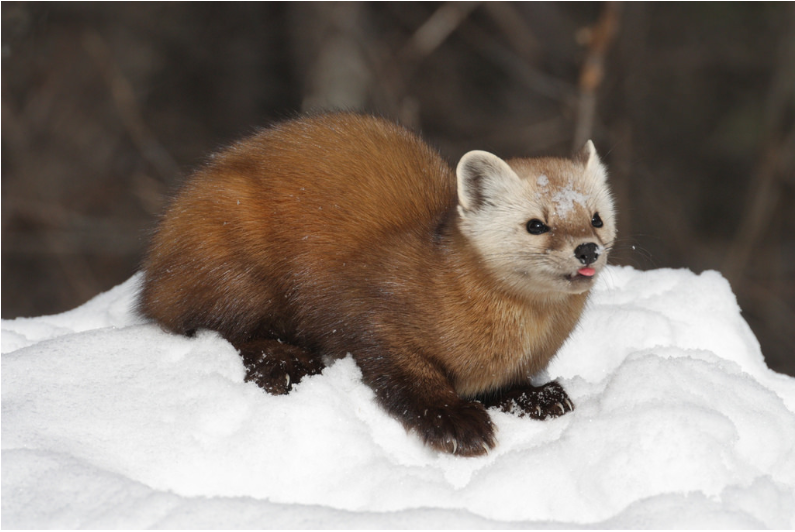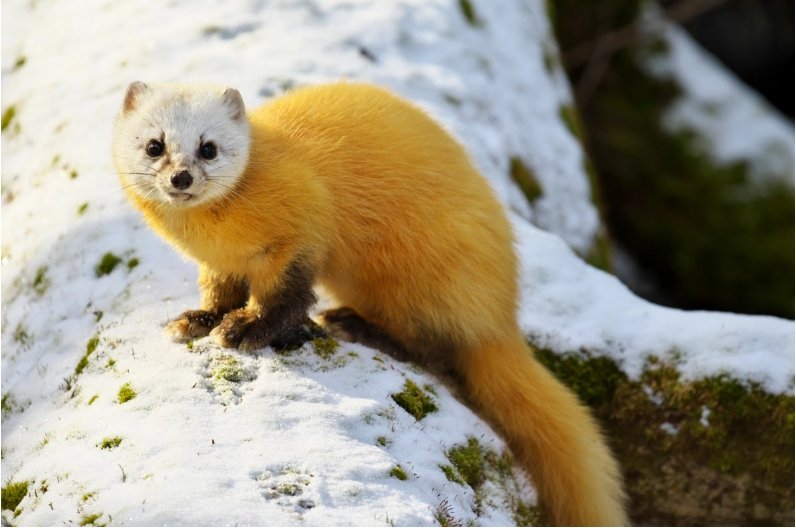Martens are a fascinating group of carnivorous mammals that are part of the Mustelidae family. These creatures are recognized for their slender bodies, bushy tails, and sharp carnivorous teeth. There are a total of eight distinct species of martens distributed worldwide, each possessing its own unique characteristics and habitat.
1. European Pine Marten
The European pine marten, also referred to simply as the pine marten, is a mustelid species that is indigenous to and widely distributed throughout Europe, Asia Minor, the Caucasus, and certain regions of Iran, Iraq, and Syria. This species is classified as "Least Concern" on the IUCN Red List, indicating that its population is relatively stable. Additionally, the European pine marten is occasionally known by alternative names such as baum marten or sweet marten.
2. Beech Marten
The beech marten, also known as the stone marten, house marten, or white-breasted marten, is a species native to much of Europe and Central Asia. It has also established a feral population in North America. The conservation status of the beech marten is currently listed as Least Concern, indicating that its population is stable.
3. Sable
The sable, a species of marten, is primarily found in dense forests across regions such as Russia, Mongolia, and China. This omnivorous opportunist sustains itself by consuming fish, small mammals, berries, and scavenging on leftovers from wolves and bears. The conservation status of the sable is currently classified as "Least Concern."
4. American Marten
The American marten, scientifically known as Martes americana, is a slender-bodied weasel similar in size to a mink. It is characterized by its relatively large, rounded ears, short limbs, and bushy tail. This species can be found from Newfoundland and Nova Scotia all the way to Alaska. Currently, the American marten is classified as "Least Concern" in terms of conservation status, although its population is decreasing.
5. Yellow-throated Marten
The yellow-throated marten, scientifically known as Martes flavigula, is a species of marten native to the Himalayas, Southeast Asia, and East Asia. This elusive creature boasts a striking coat that is bright yellow-golden, with its head and back displaying a unique blend of black, white, golden-yellow, and brown hues. Despite its captivating appearance, the yellow-throated marten is classified as a species of Least Concern, with a stable population.
6. Nilgiri Marten
The Nilgiri marten, scientifically known as Martes gwatkinsii, is the sole marten species indigenous to southern India. This elusive creature inhabits the hills of the Nilgiris and certain regions of the Western Ghats. However, its population is dwindling, with only approximately a thousand individuals remaining, leading to its classification as Vulnerable on the IUCN Red List.
7. Japanese Marten
The Japanese marten, scientifically known as Martes melampus, is a species of marten that is native to Japan. These omnivores primarily feed on fish, frogs, small birds, and mammals, but they will also consume insects, fruit, and seeds when needed. The conservation status of the Japanese marten is currently listed as Least Concern, with a stable population.
8. Pacific Marten
The Pacific marten (Martes caurina) is a carnivorous mammal belonging to the weasel family. This species is native to western North America. Unfortunately, recent surveys suggest that the population of martens on the Olympic Peninsula in Washington state is critically low. It appears that martens have been completely eradicated from the low-elevation areas where they were once found, and now only exist in small numbers in the higher-elevation regions of the peninsula.
Are Martens Related to Ferrets?
Martens and ferrets, both members of the Mustelidae family, share certain similarities due to their common ancestry. However, despite belonging to the same family, martens and ferrets are distinct species with specific characteristics that set them apart. Martens are medium-sized carnivores that can be found in Eurasia and North America, whereas ferrets are small domesticated mammals.
In terms of physical appearance, behavior, and habitat preferences, martens and ferrets differ significantly. Martens typically have slender bodies, elongated heads, sharp claws, and bushy tails, which are adaptations for their arboreal lifestyle. On the other hand, ferrets have a more compact body structure with a tapering tail. Known for their playful nature, ferrets are often kept as pets due to their social behavior.
While both martens and ferrets share similar dietary preferences as carnivores, their specific diets may vary depending on the species or subspecies. Despite some commonalities rooted in evolutionary history, martens and ferrets represent distinct branches of the Mustelidae family with unique adaptations for survival in their respective ecosystems.
Can Martens be Pets?
Although martens may exhibit traits that could make them seem like desirable pets, you need to take into account their history of domestication. Unlike ferrets, which were domesticated approximately 2,500 years ago to coexist with humans, martens have not undergone the same domestication process. Consequently, they still possess their wild instincts and can prove to be difficult to handle and train. Furthermore, in certain American states, owning a marten as a pet is prohibited.












